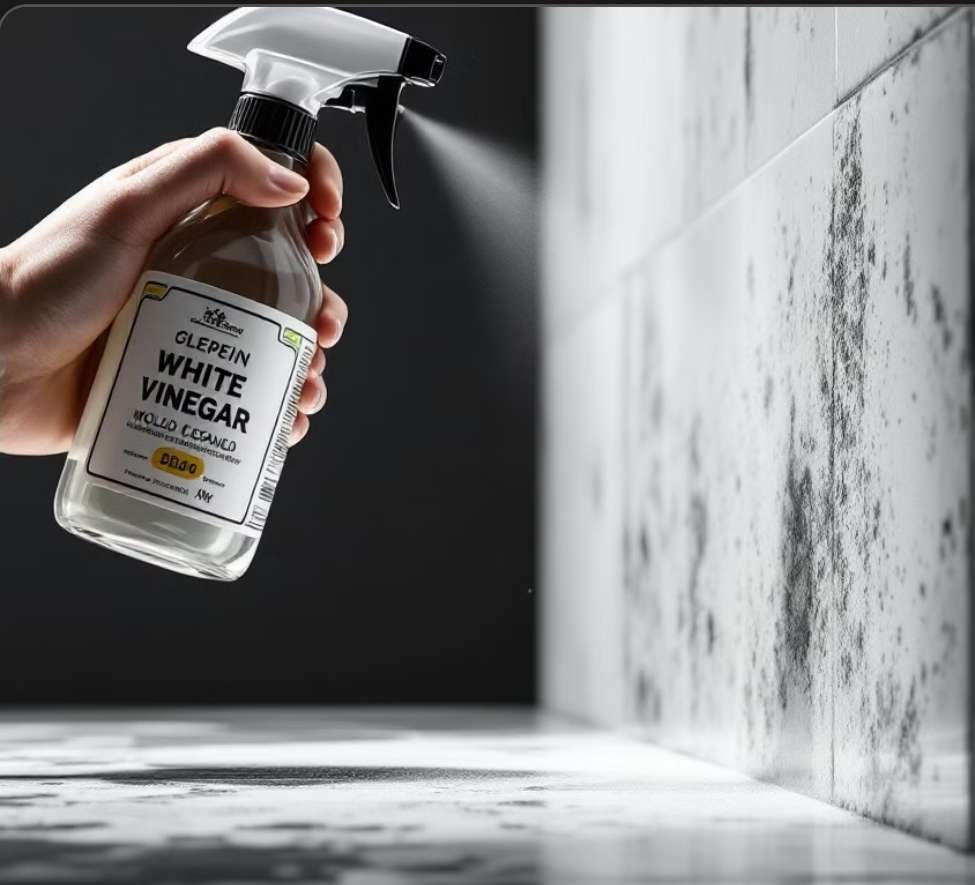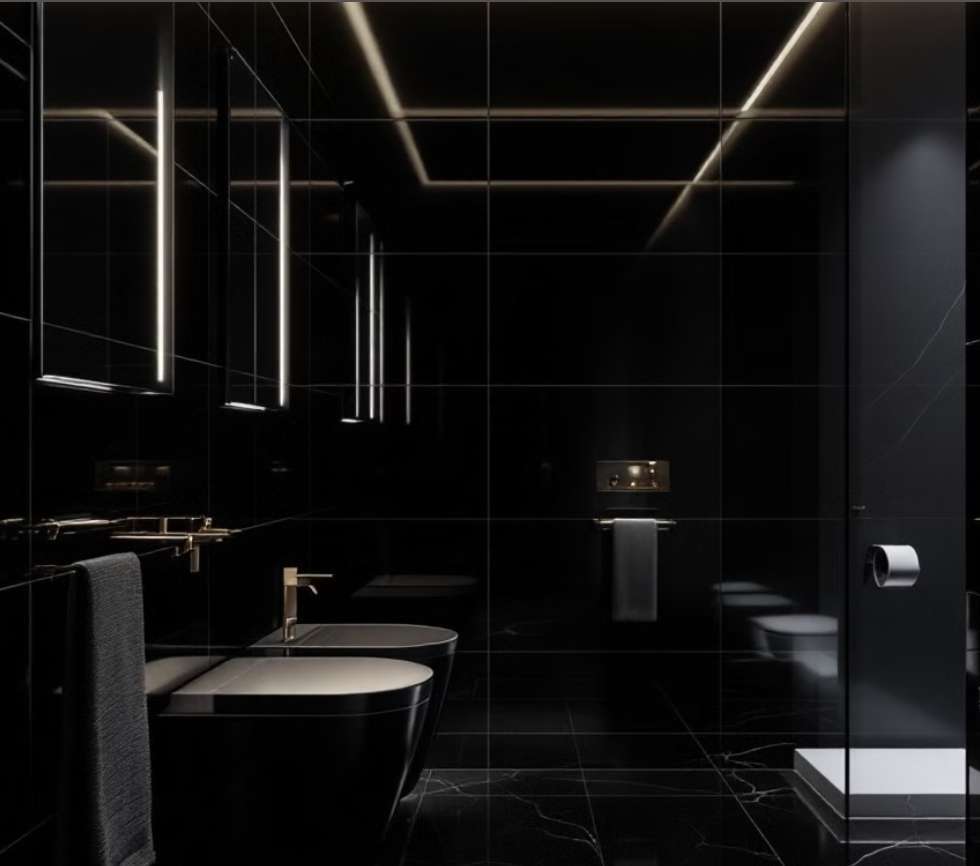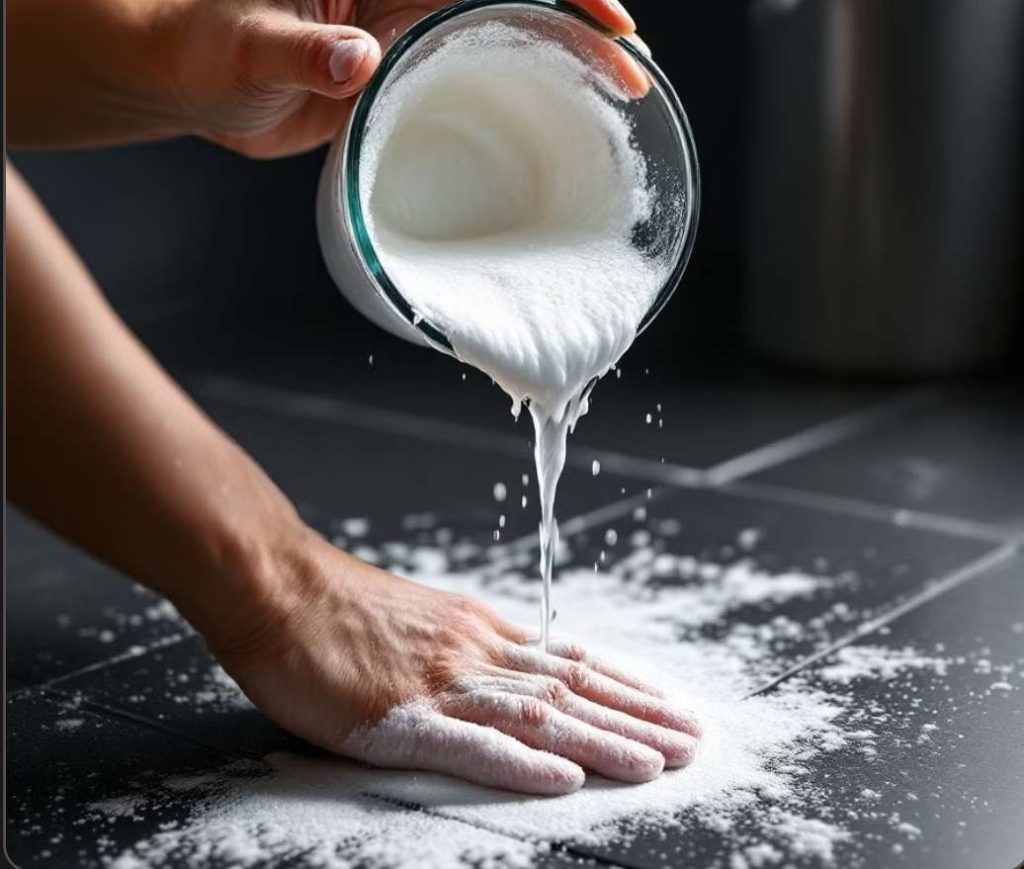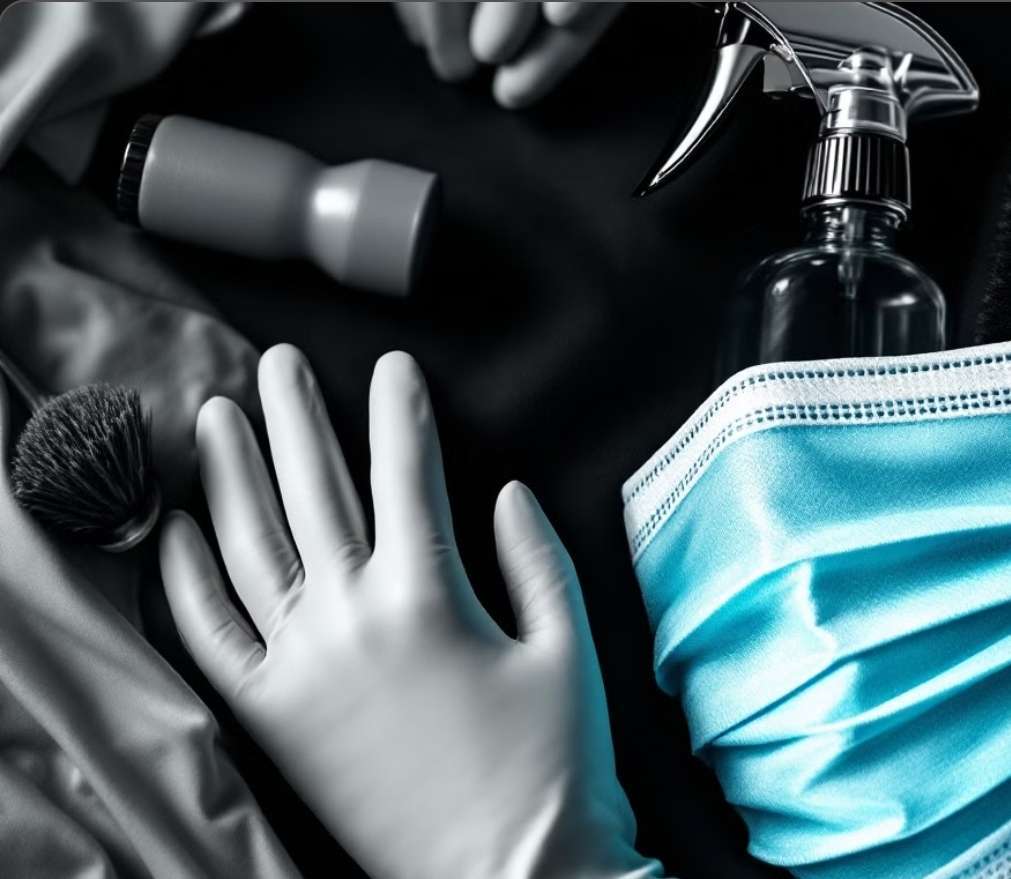Home remedies to remove mold and mildew from tiles
Tiles, especially in humid environments like bathrooms and kitchens, are prone to mold and mildew growth over time. These black and green stains not only make surfaces look unattractive but also bring several health problems. Molds, by releasing spores into the air, can cause allergies, respiratory issues, and even skin infections. In addition, the growth of fungi in the grout lines gradually leads to the deterioration of building materials and reduces their lifespan.
So, what should we do?
Many people turn to strong chemicals like bleach to solve this problem, but these substances can have a harsh, irritating smell and be harmful to health. Therefore, homemade methods are a suitable alternative. These methods are not only effective but also safe, inexpensive, and readily available. Vinegar, baking soda, tea tree oil, and even lemon juice are some of the substances that eliminate mold without the need for strong chemicals and prevent its regrowth. In the following, we will first explore the causes of fungi and mold growth on tiles and then introduce effective homemade methods to combat them.
Vinegar and baking soda solution
White vinegar and baking soda are among the most effective natural materials for cleaning mold and fungus. Vinegar has strong antibacterial and antifungal properties and can break down mold at the molecular level.
How to use:
1- Pour one cup of white vinegar into a spray bottle and spray it directly onto the contaminated surface.
2- Let the vinegar sit for one hour to break down the mold.
3- Mix an appropriate amount of baking soda with a little water to create a thick paste.
4- Using an old brush or toothbrush, apply the baking soda paste to the vinegar-sprayed surface and scrub away the mold in circular motions.
5- Finally, rinse the surface with warm water and dry it with a clean cloth.
Why is this method effective?
The combination of vinegar and baking soda not only removes mold but also prevents its regrowth. This method is an excellent option for those who prefer not to use harsh chemicals like bleach.

Using hydrogen peroxide
Hydrogen peroxide is one of the best natural disinfectants for eliminating fungus and mold. This solution has strong antifungal properties and can completely eradicate mold without damaging surfaces.
Effectiveness on Mold:
3% hydrogen peroxide easily destroys surface mold and is ideal for cleaning bathrooms, kitchens, and other damp areas.
Correct Method of Use:
Fill a spray bottle with 3% hydrogen peroxide.
Spray it directly onto the contaminated surface and let it sit for 10 to 15 minutes.
Gently scrub the mold away using a brush or sponge.
Finally, rinse the surface with warm water and dry it thoroughly.
Why is this method effective?
Hydrogen peroxide not only kills fungus, but also destroys mold spores, reducing the likelihood of future growth.
Bleach solution (Vitex) and water
Bleach (Vitex) is one of the strongest substances for removing fungus and mold. This chemical eliminates mold in just a few minutes and thoroughly cleans surfaces.
How to Mix and Correct Dosage:
Mix one part bleach with three parts water.
Pour the solution into a spray bottle and spray it on the moldy areas.
Let it sit for 10 to 15 minutes on the surface.
Use a stiff brush to scrub off the mold and rinse the surface with warm water.
Safety Tips and Warnings:
Always wear gloves and a mask when using bleach.
Do not use this solution in an enclosed space without proper ventilation.
Never mix bleach with vinegar or ammonia, as toxic gases will form.
Why is this method effective?
Bleach is an extremely powerful disinfectant that rapidly eliminates mold and fungus. However, frequent use is not recommended, as it may damage the surface of the tiles.

Tea tree oil
Tea Tree Oil is one of the most effective natural substances for eliminating fungus and mold. This oil has strong antifungal properties and, unlike chemical substances, is safe for health.
How to Use for Tiles and Grout:
Mix one teaspoon of tea tree oil in one cup of water.
Pour the solution into a spray bottle and spray it on the contaminated surface.
Allow it to sit for a few hours, then wipe the surface with a cloth.
Why is this method effective?
Tea tree oil not only eliminates fungus, but also prevents its regrowth. Its pleasant scent also replaces the unpleasant odor of mold.
Lemon juice and salt
Lemon Juice is a strong natural acid that effectively eliminates mold and disinfects surfaces.
Acidity and Its Effectiveness in Mold Removal:
Squeeze the juice of a few lemons and apply it directly to the mold.
Sprinkle a small amount of salt over the surface and let it sit for 10 minutes.
Clean the surface with a sponge and rinse with warm water.
Why is this method effective?
Lemon juice not only eliminates mold, but also freshens the surface. This method is an excellent choice for areas with moldy odors.
Methods to prevent the growth of fungus and mold
To prevent mold from regrowing, it’s important to modify the environmental conditions. Here are some effective methods to prevent mold growth on tiles:
Proper Ventilation and Use of Dehumidifiers
Always open windows or turn on the exhaust fan after taking a shower or cooking.
Use dehumidifiers in damp areas to reduce moisture levels.
Regular Cleaning of Tiles
Clean the tiles at least once a week using natural antifungal cleaning agents.
Use of Mold-Resistant Coatings
Apply waterproof sealants on the grout lines to prevent mold growth.
Drying Surfaces After Use
After showering or washing dishes, dry the surfaces with a clean towel to prevent moisture buildup.
Comparison of home and industrial methods for eliminating fungus and mold
People use either homemade methods or industrial chemicals to eliminate mold and mildew. Each method has its own characteristics, and users choose the appropriate option based on environmental conditions.
Differences Between Industrial Chemicals and Natural Methods
Industrial Chemicals such as bleach, ammonia, and strong disinfectants quickly eliminate mold but may be harmful to human health and the environment.
Natural Methods, like using vinegar, baking soda, lemon juice, and tea tree oil, are safer alternatives that not only remove mold but also reduce the likelihood of it returning.
Advantages and Disadvantages of Each Method
Homemade Methods: Safe, cost-effective, gentle on tile surfaces, but may require more time to show results.
Industrial Methods: Fast and powerful, but can cause skin irritation, respiratory issues, and damage to surfaces.
Recommendation for Choosing the Best Option
If the mold is widespread or old, industrial chemicals may be useful at first. However, for ongoing maintenance and prevention, natural methods are recommended. Additionally, in environments with poor ventilation, natural methods are a better option.

The role of ambient temperature in the growth or destruction of molds
The temperature of the environment has a direct impact on the growth of mold and mildew. Mold tends to grow more rapidly in warm and humid conditions, but very high or low temperatures can prevent their spread.
How Temperature Affects Mold Growth
Mold thrives between 20 to 30°C (68 to 86°F), where it reproduces quickly.
At temperatures below 5°C (41°F), mold growth slows down but doesn’t stop entirely.
Temperatures above 60°C (140°F) can kill most types of mold.
Can Temperature Changes Be a Solution for Prevention?
Yes, controlling the environment’s temperature can help reduce mold growth:
Using heating systems in winter and ensuring proper ventilation in summer can significantly slow down mold growth.
Drying the environment with warm air or sunlight can deactivate mold.
In refrigerators or cold storage areas, it’s important to maintain good ventilation to prevent moisture buildup and mold growth.
The effect of sunlight and UV rays in destroying fungus and mold
Sunlight is one of the best natural disinfectants. The UV rays in sunlight can break down mold and mildew spores and stop their growth.
Can Direct Sunlight Eliminate Mold?
Yes, mold and mildew thrive in dark, damp environments. Placing mold-affected items in direct sunlight for a few hours helps eliminate them.
Effectiveness of UV Lamps in Humid Environments (e.g., Bathrooms)
UV-C lamps are used in hospitals and laboratories to disinfect spaces.
In areas like bathrooms where sunlight is limited, UV lamps can help reduce mold growth.
Best Method to Use Light for Mold Removal
In environments with sunlight, keep windows open so direct sunlight can reach the tiles and other surfaces.
Use UV disinfectant lamps in moist and low-light places like bathrooms, storage rooms, and basements to reduce mold growth.
How to protect the joints between tiles from mold?
The gaps between tiles are ideal spots for mold and mildew growth. These areas are highly vulnerable due to water and moisture infiltration, and if not properly maintained, mold can spread quickly.
The Importance of Proper Grouting for Tiles
Healthy grout prevents water from penetrating beneath the tiles and helps avoid mold growth.
Keeping the grout between the tiles clean prevents the formation of black mold spots.
Materials to Prevent Moisture Infiltration in Gaps
Waterproof Silicone: Silicone grout sealer is the best option to prevent water from seeping into the tile grout.
Anti-Mold Sprays: Using specialty tile grout sprays helps prevent mold growth.
Vinegar and Baking Soda Solution: This combination is highly effective for cleaning and disinfecting tile gaps.
Tips for Maintaining Tile Grout
At least once a month, clean the gaps with vinegar or anti-mold solutions.
Every few years, inspect the grouting and repair any damaged areas.
After showering or cleaning, dry the tile surfaces and gaps to prevent mold growth.

Investigating the effect of houseplants in reducing humidity and eliminating mold
Houseplants not only enhance the beauty of a space but also help reduce humidity and prevent mold growth. Some plants have moisture-absorbing properties and help purify the air.
Plants That Help Reduce Humidity
Boston Fern: One of the best plants for absorbing moisture in humid environments such as bathrooms.
Ivy (Hedera): Known for its air-purifying properties and preventing the spread of mold.
Bamboo Palm: Naturally reduces humidity and keeps the air clean.
Sansevieria: In addition to reducing humidity, it helps in absorbing pollutants and improving air quality.
The Effect of Natural Air Purifiers on Mold Growth
Plants like Aloe Vera, Spider Plant, and Peace Lily can reduce toxins in the air and prevent mold growth.
Placing plants in areas like bathrooms and kitchens helps regulate humidity and prevents mold expansion.
How to eliminate the unpleasant odor caused by mold?
Moldy odors are a common problem in humid environments. This smell is caused by the accumulation of fungi and mold in closed spaces, and it can be quite unpleasant. Fortunately, there are effective natural methods for eliminating this odor.
Natural Methods to Eliminate Moldy Odor
Baking Soda:
Place a bowl of baking soda in the affected area. Baking soda absorbs unpleasant odors and helps freshen the air.White Vinegar:
Place a cup of white vinegar in the room to reduce the moldy smell. You can also spray a mixture of vinegar and water on the affected surfaces.Activated Charcoal:
Activated charcoal has odor-absorbing properties and is very useful for eliminating mold odors in bathrooms and kitchens.
Tips to Prevent the Return of Moldy Odors
After cleaning, make sure to dry surfaces completely.
Ensure proper ventilation and use dehumidifiers.
Use plants that help reduce humidity to keep the air fresh.
The role of natural disinfectants in reducing fungus and mold
Natural disinfectants can eliminate mold and fungi without causing chemical damage. Some of these substances, in addition to their cleaning properties, help prevent mold from regrowing.
Anti-Fungal Properties of Natural Materials
White Vinegar: A powerful disinfectant that breaks down mold and prevents its growth.
Baking Soda: With its alkaline properties, it creates an environment unsuitable for mold growth.
Salt: In addition to disinfecting, it absorbs water and reduces the humidity of the environment.
Tea Tree Oil: One of the strongest natural anti-fungal agents, effective for disinfecting tiles.
Isopropyl Alcohol: A strong disinfectant that is effective for eliminating fungi on tiles.
How to Combine and Use These Materials
For cleaning tile surfaces, mix one cup of vinegar with one cup of water and spray it on the surfaces.
Mix one tablespoon of tea tree oil in one liter of water and spray it on moldy spots.
Sprinkle baking soda directly on the mold and wash it off with warm water after a few minutes.
By regularly using these materials, you can prevent mold from regrowing and maintain a clean, healthy environment.

Can proper ventilation prevent mold growth?
Yes! Proper ventilation is one of the most effective solutions to prevent the growth of mold and fungi. When air doesn’t circulate in a space, humidity increases, creating ideal conditions for mold growth.
Best Ventilation Methods for Bathrooms and Kitchens:
Use of Exhaust Fans: Bathroom and kitchen exhaust fans reduce humidity and prevent mold formation.
Keep Windows Open: Let fresh air in during the day to prevent condensation buildup.
Use of Dehumidifiers: In areas with high humidity, dehumidifiers are highly effective in controlling moisture levels.
Importance of Proper Ventilation in Preventing Mold Growth:
Reduces moisture vapor and prevents condensation on surfaces.
Promotes faster drying of tiles and prevents the formation of moldy black spots.
Creates an unfavorable environment for the growth of fungi and bacteria.
Regular ventilation, combined with consistent cleaning, is one of the best ways to prevent mold growth.
Common mistakes in removing mold and mildew
Many people make mistakes when trying to remove mold, which can actually make the situation worse. Some of these mistakes can even lead to health risks.
Common Mistakes and Why They Are Wrong:
1- Overuse of Bleach (Witeks):
- While bleach can kill mold, excessive use can damage the surface of the tiles.
- The fumes from bleach can also cause respiratory problems and irritation.
2- Not Drying Surfaces Completely After Cleaning:
- If tiles are not dried properly after cleaning, residual moisture creates an ideal environment for mold to regrow.
3- Not Cleaning the Grout Between Tiles:
- Many people focus on cleaning the surface of the tiles but ignore the grout lines.
- Mold often grows in the grout between tiles, so cleaning these areas is essential.
4- Using Wet Wipes to Clean Mold:
- Using wet wipes to clean mold can spread it to other areas of the tiles, making the problem worse.
Alternative methods to prevent mold from returning
- After every wash, use a dry cloth to wipe down the surfaces.
- Every few weeks, use a vinegar and baking soda solution to clean the surfaces.
- Ensure proper ventilation to prevent moisture buildup in the environment.
By following these tips, you can prevent mold from returning and maintain a clean and healthy environment.
Conclusion
The growth of fungi and mold on tiles not only makes the environment look unappealing but can also pose serious health risks and damage to building materials. Using natural home remedies such as vinegar, baking soda, and tea tree oil effectively removes mold and prevents its regrowth. These methods are efficient, safe, and cost-effective. Additionally, keeping surfaces dry, using dehumidifiers, and regular cleaning are key strategies for prevention. By following these tips, you can maintain a healthy, clean, and mold-free environment.

